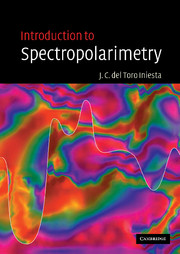Book contents
- Frontmatter
- Contents
- Preface
- Acknowledgements
- 1 Historical introduction
- 2 A review of some basic concepts
- 3 The polarization properties of quasi-monochromatic light
- 4 Linear optical systems acting on polarized light
- 5 Solar polarimetry
- 6 Absorption and dispersion
- 7 The radiative transfer equation
- 8 The RTE in the presence of a magnetic field
- 9 Solving the radiative transfer equation
- 10 Stokes spectrum diagnostics
- 11 Inversion of the RTE
- Index
7 - The radiative transfer equation
Published online by Cambridge University Press: 11 August 2009
- Frontmatter
- Contents
- Preface
- Acknowledgements
- 1 Historical introduction
- 2 A review of some basic concepts
- 3 The polarization properties of quasi-monochromatic light
- 4 Linear optical systems acting on polarized light
- 5 Solar polarimetry
- 6 Absorption and dispersion
- 7 The radiative transfer equation
- 8 The RTE in the presence of a magnetic field
- 9 Solving the radiative transfer equation
- 10 Stokes spectrum diagnostics
- 11 Inversion of the RTE
- Index
Summary
Y entonces, el maestro sacó la daga, y dijo: —“Yo no sé quién es Ángulo ni Obtuso, ni en mi vida oí decir tales nombres; pero, con ésta en la mano, le haré yo pedazos”.
—F. de Quevedo y Villegas, 1603?And then the master drew his dagger and said, ‘I never in my life heard of Angle or Obtuse, but with this in my hand I'll cut him to ribbons.’
So far we have been dealing with the propagation of light through media whose refractive indices have been assumed to be constant with position (the assumption of homogeneity). We are now able to embark on the study of the propagation of light through media whose refractive indices – and hence absorptive and dispersive properties – may vary along the ray path; a differential treatment is then in order. More specifically, we shall deal with stratified media whose material properties are constant in planes perpendicular to a given direction. Moreover, our study will not only include passive systems but emission properties of the medium will also be considered (although in the most simplified way).
There are three main hypotheses we should add to proceed with the development that follows:
We shall assume that the absorptive, dispersive, and emissive properties of the medium are independent of the light-beam Stokes vector. This is in fact a linear approximation that holds in many astrophysical applications, where, even though the medium may be dependent on the whole radiation field, the angular width of the beam (indeed within the realm of geometrical optics) is so small that its contribution to the physical conditions of the medium can be neglected (e.g., Landi Degl' Innocenti and Landi Degl' Innocenti 1981).
[…]
- Type
- Chapter
- Information
- Introduction to Spectropolarimetry , pp. 102 - 120Publisher: Cambridge University PressPrint publication year: 2003



